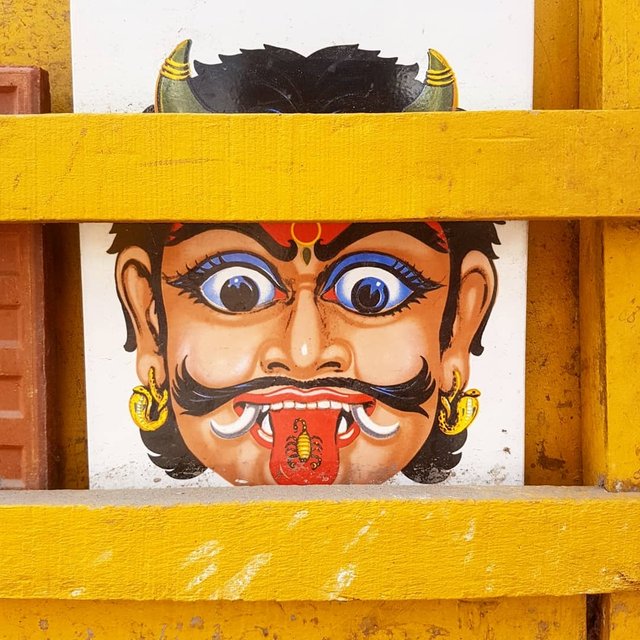Casting Away The Evil Eye | South Indian Style
Dhrishti Bommais are a common sight across Tamil Nadu. They are hung at the entrance of households, shops, economic ventures, bikes and other objects to ward off the evil eye.
The Dhrishti Bommai is usually a fearsome demon that is painted on a metal plate or tile that is said to ward off the evil eye. (Dhrishti - evil eye, Bommai - doll)
Other means to ward off the evil eye are to tie some lemons together with green chillis, breaking pumpkins, circling a coconut around a person. New born babies are often given a kohl made circle on the cheek for this very purpose.
Over the weekend, someone at a wedding came up to me and said I have very beautiful eyes. That very night, my eye turned red, I found out I had some lesions in my cornea and had to postpone my ticket to Seoul. Concerned relatives have all been calling with various methods on how to get rid of the evil eye that has been cast on me.
What are yours? Does your culture have any practices to ward off the evil eye?



They don't seem to have anything of that type here in France. I hope your eye has healed.
A friend once told me that if someone puts a baguette the wrong side up on the dinner table, it means that the household has a touch of the evil eye. He was probably playing around with me but I have come across various other instances where I've been told that flipping the baguette on its side brings bad luck. Oh well!
Yes, my eye is so much better now. I should catch that flight tomorrow and get back to work, finally!
Here is the origin:
Depuis le Moyen Âge et jusqu’au début du XXe siècle (1), dans certaines familles, les gens croyaient que mettre le pain à l’envers apportait le malheur dans la maison.
Mais pourquoi les gens croyaient-ils cela ?
Il faut remonter au Moyen Âge pour trouver l’origine de cette superstition. À cette période, les exécutions des condamnés se déroulaient sur les places pendant les jours de marché et vers midi. Ces mises à mort étaient publiques et attiraient une foule nombreuse. Le spectacle était gratuit et terriblement angoissant.
Le bourreau était aussi craint et respecté que haï. Personne ne s’approchait de lui. Tout le monde avait peur et les boulangers rechignaient à le servir. Il fallut un décret royal pour obliger les boulangers à mettre de côté un pain pour le bourreau, les jours d’exécution.
Alors, par contestation et pour marquer la différence, les boulangers prirent l’habitude de retourner le pain du bourreau sur leur étal.
C’est l’origine de la superstition qui consiste à croire qu’un pain mis à l’envers sur la table apporte le malheur et laisse entrer le diable dans la maison.
Oh wow. The whole thing stems from the fear of an executioner?! I almost feel sad for the man 'aussi craint et respecté que haï'. Imagine not being served food simply because of a job that you've been commissioned to do!
But I guess this is how superstitions like the evil eye are created.
I guess hired assassins were not well considered. Horrid karma.
What I find contradictory is that putting people to death was some sort of sordid entertainment.
Not only was it entertainment, I think it was also a way to scare people. That's why it happened in such a public place, no? It was to rule by instilling fear - a strategy that hasn't changed much til date.
Yes, unfortunately you are right.
Interesting. Always love to read about culture things, made me feel so small in this big big world :)
Plus, your photos are awesome!
Glad you enjoyed the read, @gibic! We live in a world of myriad cultures and its astounding how little we know about it.
My photos are mostly just point-and-shoot phone photos but I'm glad you like them. Thanks for stopping by!
I don't know if Dhrishti Bommais would scare off the evil eye, but it would scare me off :) My mother would never say she was superstitious, but she was devoutly Catholic. Whenever there was a report of bad news, she would cross herself (make the sign of the cross). She would reject the idea completely that this was superstitious, but there was no doubt she was invoking the protection of God. Same for pictures of statues or favorite saints. These offered protection from different kinds of harm. One person's religion is another person's superstition, I guess.
Oooooh, so true. I call my mother superstitious all the time. She agrees that it's superstition but follows it anyway.